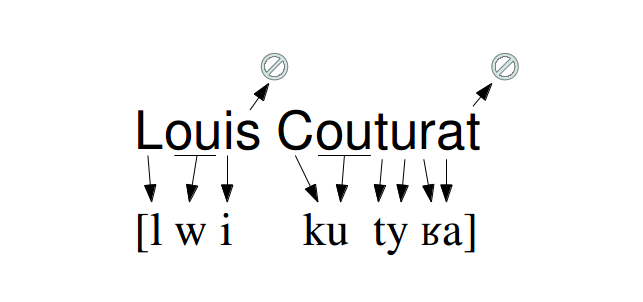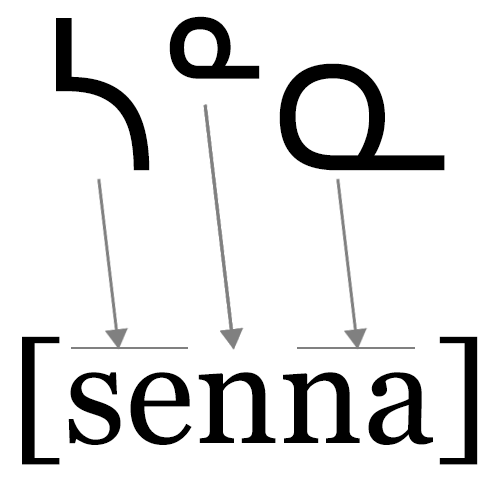Writing systems
"How to put it on paper"
"How to put it on paper"
A writing system is an organized method for storing and transfering messages on the basis of a language. Most often writing is visual (less often tactile) with a set of signs or symbols, usually known as characters.
Generally, threre are three major types of writing systems:
Alphabets use a standard set of letters representing the consonants and vowels of a spoken language. The correspondence is almost never one-to-one. Usually several different letters represent one phoneme and/or several phonemes are represented by the same letter. Alternately, a sequence of two or more letters can represent a single phoneme.

Relations between letters and phonemes in an alphabetic script. Note the silent letters 's' and 't'.
Syllabaries consist of symbols that represent syllables (which are considered to be a basic building block of the words).

Relations between character and syllable in a syllabary. Note the representation of a single consonant [n]. (The name of a dwarf planet 90377 Sedna in Inuktitut)
Logographies use characters corresponding to words, morphemes or other semantic units.

Esperanto = "universe" + language = (generation/world/era + boundary/domain) + language
Relations between characters and morphemes in a logographic script. “世界” is a loanword from Sanskrit and its meaning is opaque to modern speakers.
The division is not entirely clear cut - there are writing systems that feature elements from other categories, for example the English symbol & stands for the word (semantic unit) and, and not a vowel nor a consonant.
There are also some classes of writing systems that are variations of others. For example an abjad is an alphabet where consonants are written but most vowels are not. Typical examples include the Arabic and Hebrew scripts. In an abugidas, the consonants have full forms while the vowels are indicated by modifications or additions to the consonants. Typical examples are the Amharic script of Ethiopia or Devanegari (and related) scripts of India.
Writing is usually carried out by making distinctive marks on a 2D surface, in specific shapes. Materials that could be (and have been) used to write upon are include paper (the most common until very recently), stone, clay, sand, animal skin, birch bark or even, symbolically, the air (performed (fictionally) by a protagonist of Kurt Vonnegut's Galapagos) and many other materials.
The marks could be made by paint, incision, burning, impressions or printing among other ways.
A writing system is an abstract notion - letters can take various shapes (such as Latin a and a) and still be considered the same letter, or could visually look the same (such as Latin c and Cyrillic c) but represent different sounds.
Various non-visual representations of letters are not considered separate scripts - most known are Braille, tactile writing composed of raised bumps, which should be felt by touch (used by visually impaired people); International maritime signal flags, where the letters are represented by various flags; Morse code, where the letters are represented by "dots" and "dashes", either by tones, flashes or beeps; or computer encodings, where the characters are represented in purely abstract way as a sequence of bits.
The common direction used in writing is left-to-right, then top-to-bottom, where the text is arranged in lines. Sometimes the text can be written vertically (mostly due to space constraints, as on street signs or banners) and then the direction goes top-to-bottom, then left-to-right.
Notable exceptions are the Arabic and Hebrew scripts which are written right-to-left, then top-to-bottom.

Direction of reading, modern Arabic script
Chinese and Japanese can also be written left-to-right, then top-to-bottom, but the traditional way of writing was vertical, top-to-bottom, then right-to-left (arranged in columns). Both languages are quite often written this way.
The Mongolian traditional script (still used in Inner Mongolia in China) is written vertically, top-to-bottom and then left-to-right.
A large majority of the major languages in Europe use the Latin script. Most of them add diacritics or additional letters (like Icelandic's ð, þ). Bulgarian, Serbian, Macedonian, Belarussian, Ukrainian and Russian use the Cyrillic script, each with slight variations of specific letters. Serbian is also often written using the Latin script. Romany (though rarely written) is written in Cyrillic in countries where the primary language uses that script.
Greek is, at present, the only language using the Greek alphabet. Similarly, on the border between Europe and Asia, the Georgian and Armenian languages are both written in their own specific alphabets.